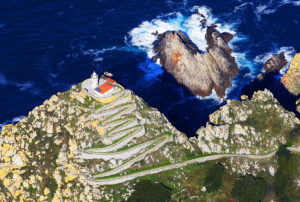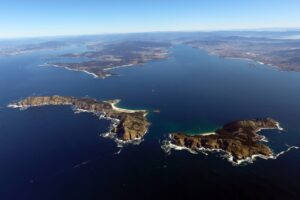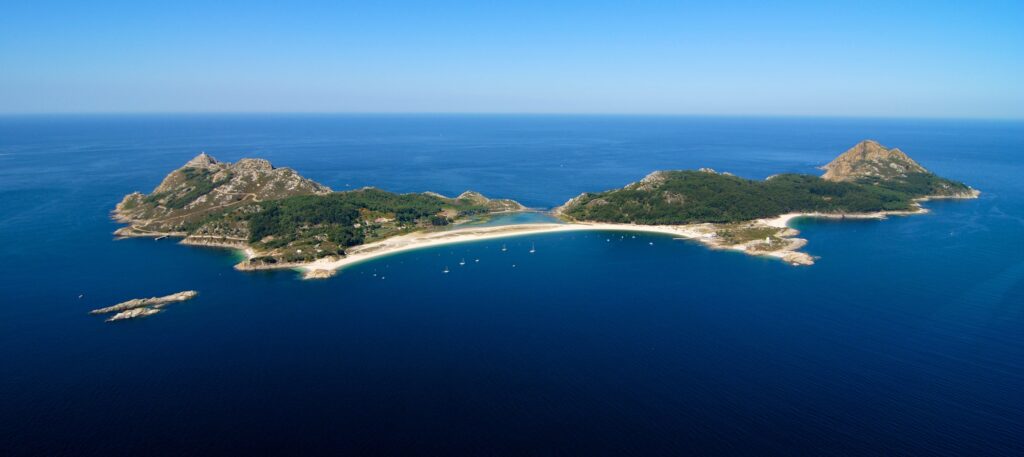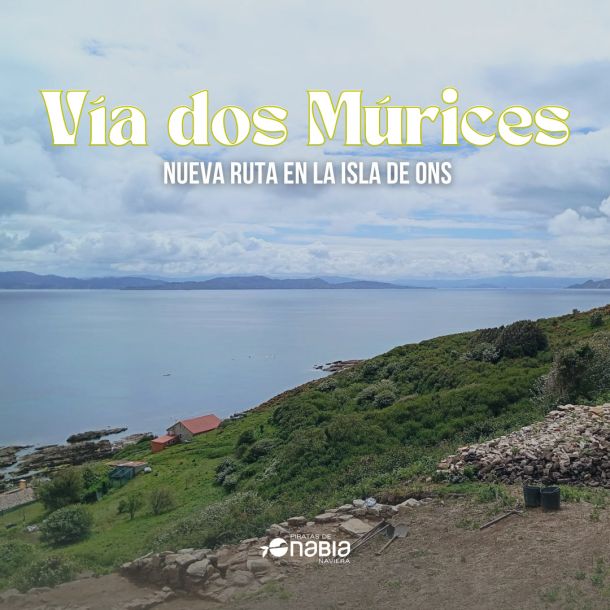TOPONYMS OF CÍES – 2
Place names are cultural heritage of a people, they speak of its history, what happened in a place, to whom a domain belonged, an event, the resemblance in its shape with an animal, the face of a person, etc. After the island of San Martiño, in the second installment we will talk about the toponyms of the island of Montefaro, do Medio or de Abaixo.
Yes, we are in the archipelago of the Cíes Islands, within the Parque Nacional das Illas Atlánticas de Galicia.
What is a “toponym” for the R.A.E.? “1. m. Ling. Proper noun of place. (From the Greek “topos” place).
As we said in the first installment, toponyms are part of our intangible heritage, so preserving them and knowing them enriches us culturally.
Let us not allow these place names to be lost to ignorance, depopulation and the abandonment of lands and customs.

The place names of Montefaro
To begin with we find an island baptized with up to three different names: Montefaro, do Medio, or De Abaixo, are the three denominations that the island “in the middle” receives in the archipelago of the Cíes Islands.
The island takes its name from the famous lighthouse, the main lighthouse of the Cíes, which crowns its highest point, at the end of the most popular route for hikers visiting the Cíes. In its final zig-zag are the tracks of thousands of hikers who every year climb to contemplate one of the most wonderful views of the National Park.
Montefaro is linked to Monteagudo (or North Island) by the Area das Rodas and by a breakwater construction that allows walking between the two islands and even transport between the pier and the campsite or other houses and services. At the same time, the breakwater separates and protects the lake and the Rhodes area from the lake inlet.
Islets, points and inlets
Two islets emerge on the east side of Montefaro Island, the penela dos Viños and the punta das Vellas. In the west of the island is the illote do Ruzo, a steep rock separated from the rest of the island by the formation of two furnas, and to the north is the penela of Carabelos. Next to the penela are the Carabelos point and the Carabelos curuto, a height of only 50m above sea level.
Other points with their own name, almost cinematographic, are A Popa da Fragata and O Cu da Nau.
In the south and east of the island are located the Canaval point, the Manteca point and Carnacido point, the latter next to the Carnacido spring and the pier of the same name, which allowed landing on the island in a protected area on the inner side of the estuary and also by the penela dos Viños.
Furnas in Montefaro
The furnas are originated by the push of the sea that causes cavities in the wall of the island, more common in the western area, exposed to the constant oceanic pounding.
From north to south we find the furna das Herbas, the furna da Fornaca das Bogas and the furna do Buraco de Trapo, which “guard” the enseada do Sino. Further south we have the furna do Inferno, reminiscent of its “big sister of the island of Ons”, the Buraco do Inferno, the protagonist of stories, legends and even a novel: “the sons of the sea” by Pedro Feijoo.
The furnas das Follas and do Pozo, on the other hand, delimit the illote do Ruzo, a rugged rocky outcrop already mentioned above. There are still two more furnas in Montefaro, the furna dos Araus and the furna da Porta, in the south of the island.

Beaches, inland
From south to north we start by the area dos Bolos, which “joins” the Punta das Vellas to the island of Montefaro, at the end of the beach of Rodas.
The main beach of Montefaro is the area of Nosa Señora. The Fonte de Nosa Señora is also located there. It is 140m long and 19m wide. Other names it receives are Carnacido beach or Chuco beach, for being next to the house of Chuco, where Germán Luaces lived, the last inhabitant of the Cíes Islands, who died in 2018.
To the south, flanked by the Manteca point, is the Pequena area, as its name indicates, one of the smallest in the archipelago.
Inland
The highest points on the island of Montefaro are the Montefaro high point, at 175m, where the main lighthouse of the Cíes is located, Monte Caberta, at 165m, Alto do Portelo at 172m and Alto de Carnacido at 152m.
Between the lighthouse of Cíes and the lighthouse of da Porta is the castrexo settlement, later Romanized, of the castro das Hortas, next to the Fontiña das Hortas.
Halfway along the route that leads to the Cíes lighthouse is the famous Pedra da Campá, a significant example of the sculptural power of Nature. And if the strength does not falter, the walker can follow the trail to the viewpoint of the birds of Alto da Campá, which will allow to attend the dance of the flight of the seagulls over the cliffs and the concert of their squawks.
Cíes constructions
In addition to the aforementioned castro das Hortas and the Casa de Chuco, other constructions bear witness to the human presence in the Cíes Islands for habitation, strategic and military reasons, and more recently for tourism and the promotion of the Parque Nacional das Illas Atlánticas de Galicia (National Park of the Atlantic Islands of Galicia).
For tourist use, on the island of Montefaro is the Cíes Islands Campsite, which has a restaurant and store. In addition to other buildings and houses. The population of Cíes abandoned the island due to the innumerable pirate attacks that occurred on the Galician coast during the 16th century.
The Monastery of Santo Estevo dates back to the 6th century and was converted into an artillery storehouse in the 19th century, when the Carabineros barracks and the Casa do Polvorín were built, as well as the Casa do Calabozo (an island prison), all within a plan to fortify the Cíes. Salting factories, taverns, nurseries, followed one after the other, maintaining a small population on the island during the 20th century.
Today, the island of Montefaro receives mainly hikers eager to know and get in touch with the natural environment of the National Park in Cíes.

Do you want to know more about the CIS ISLANDS? In this link we tell you 5 curiosities about Cíes, enjoy it!


